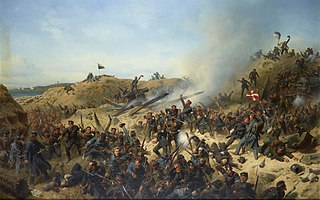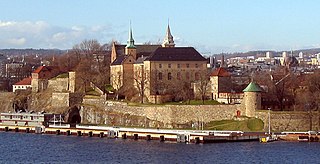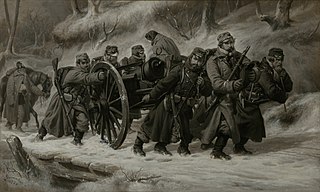
Bornholm is a Danish island in the Baltic Sea, to the east of the rest of Denmark, south of Sweden, northeast of Germany and north of Poland.
Danish Defence is the unified armed forces of the Kingdom of Denmark charged with the defence of Denmark and its self-governing territories Greenland and the Faroe Islands. The Defence also promote Denmark's wider interests, support international peacekeeping efforts and provide humanitarian aid.

Rønne is the largest town on the Danish island of Bornholm in the Baltic Sea. It has a population of 13,807. It was a municipality in its own right from 1970 until 2002, when Bornholm was a county. It has an area of 29.11 square kilometres, and is the administrative centre of the Bornholm municipality. As of 2018 11,539 inhabitants live in Rønne Parish, which is a narrow piece of land on the westernmost of the island and stretching north and southward comprising around a third of the area of the former municipality. Knudsker Parish made up the rest of the former municipality. Not all inhabitants of either Rønne or Knudsker (400-7553) parishes live in the city of Rønne.

The Royal Danish Army is the land-based branch of the Danish Defence, together with the Danish Home Guard. For the last decade, the Royal Danish Army has undergone a massive transformation of structures, equipment and training methods, abandoning its traditional role of anti-invasion defence, and instead focusing on out of area operations by, among other initiatives, reducing the size of the conscripted and reserve components and increasing the active component, changing from 60% support structure and 40% operational capability, to 60% combat operational capability and 40% support structure. When fully implemented, the Danish army will be capable of deploying 1,500 troops permanently on three different continents continuously, or 5,000 troops for a shorter period of time, in international operations without any need for extraordinary measures such as parliamentary approval of a war funding bill.

The Second Schleswig War, also sometimes known as the Dano-Prussian War or Prusso-Danish War, was the second military conflict over the Schleswig-Holstein Question of the nineteenth century. The war began on 1 February 1864, when Prussian and Austrian forces crossed the border into the Danish fief Schleswig. Denmark fought troops of the Kingdom of Prussia and the Austrian Empire representing the German Confederation.

Akershus Fortress or Akershus Castle is a medieval castle in the Norwegian capital Oslo that was built to protect and provide a royal residence for the city. Since the Middle Ages the fortress has been the namesake and centre of the main fief and later main county of Akershus, which was originally one of Norway's four main regions and which included most of Eastern Norway. The fortress itself was located within the Akershus main county until 1919, and also within the smaller Akershus sub county until 1842.

The Royal Life Guards is a mechanized infantry regiment of the Danish Army, founded in 1658 by King Frederik III. The primary task is to provide a number of soldiers from the Guard Company to serve as a guard/ceremonial unit to the Danish monarchy, while training the Royal Guards for various functions in the mobilisation force. Until its disbandment, the Royal Horse Guards, served the role as the mounted guard/ceremonial unit, afterwards the role was taken over by Guard Hussar Regiment Mounted Squadron. During the time period 1684–1867, the Royal Life Guards were called The Royal Foot Guard, in order to distinguish between the regiment and the Royal Horse Guards.

The Danish Home Guard (HJV) is the fourth service of the Danish military. It was formerly concerned only with the defence of Danish territory, but since 2008, it has also supported the Danish military efforts in Afghanistan and Kosovo. Service is voluntary and unpaid, though members' loss of income from time taken off work, transport expenses and other basic expenses are compensated. However, workshop and depot staff plus clerks and senior officers are all paid. The unarmed Women's Army Corps (Lottekorpset) was merged in 1989 with the then all-male Home Guard to form the present, armed unisex Home Guard.

Dybbøl is a small town with a population of 2,339 in the southeastern corner of South Jutland, Denmark. It is located around 6 km (3.7 mi) west of Sønderborg. It is mainly known for being the site of a famous last stand battle in 1864.

Aalborg or Ålborg, is Denmark's fourth largest urban settlement with a population of 119,862 in the town proper and an urban population of 143,598. As of 1 July 2022, the Municipality of Aalborg had a population of 221,082, making it the third most populous in the country after the municipalities of Copenhagen and Aarhus. Eurostat and OECD have used a definition for the Metropolitan area of Aalborg, which includes all municipalities in the Province of North Jutland, with a total population of 594,323 as of 1 July 2022.

Sønderborg is a Danish town in the Region of Southern Denmark. It is the main town and the administrative seat of Sønderborg Municipality (Kommune). The town has a population of 27,766, in a municipality of 73,711. In recent times, Sønderborg is a center for trade, tourism, industry, and education in the region of Southern Denmark. The town is the headquarters for several industrial companies. Sønderburg joined the UNESCO Global Network of Learning Cities in 2016.

Rebild National Park is a protected area located in Rebild municipality in Region Nordjylland in Denmark.

During the Second War of Schleswig, the fortifications of Danevirke were evacuated by the Danish army in 1864. This marked the last military use of the ancient defence structure of Danevirke, which has remained in German possession ever since.

Rosenborg Barracks, one of two barracks of the Royal Danish Life Guard, is located next to Rosenborg Castle in Copenhagen, Denmark. Its address is Gothersgade but it has a long facade along Øster Voldgade.

The Royal Horse Guards was a Cuirassier regiment in the Royal Danish Army which was founded on orders from King Frederick III in January 1661 and discontinued on 31 May 1866. It served both as Royal Guards and as a front line cavalry unit.

Ernst Lohse was a Danish architect and designer known for his colourful post-modernistic style as well as stylised country and cityscapes of quintessential Danish motifs. Together with architect Bente Schaltz he ran the design studio The Green Studio from 1973 until 1990.

The Uniforms of the Royal Danish Army distinguish soldiers from other service members. Royal Danish Army uniforms were originally influenced by French, Prussian and Russian military traditions. However, in more recent times, its uniforms have been characterized as being influenced by British uniforms, and, more significantly, American uniforms.

The Royal Guard Company is the part of Royal Life Guards which serves as an active protection force for the Danish royal family. Of the 300 in the company, 280 are conscripts.


















